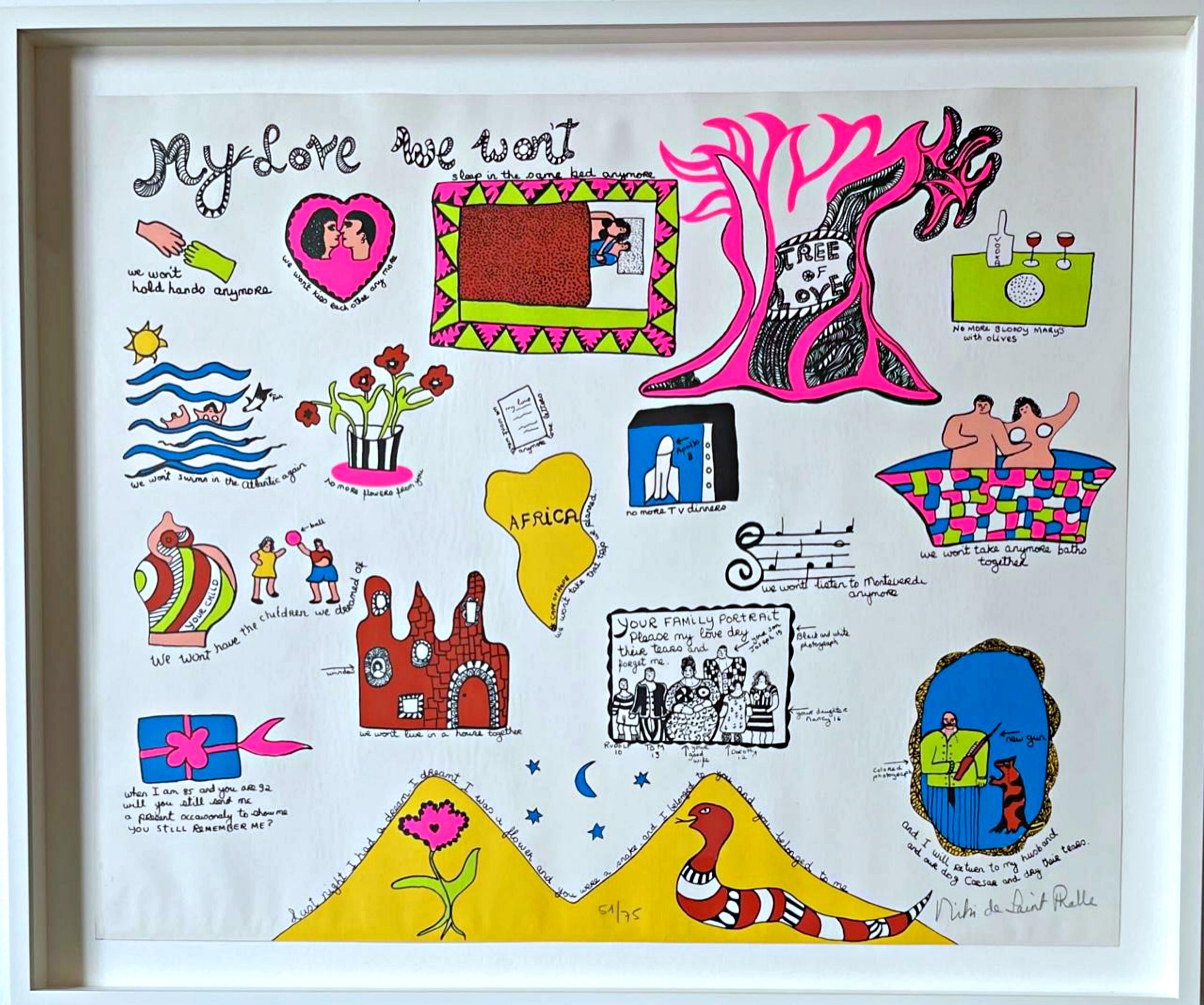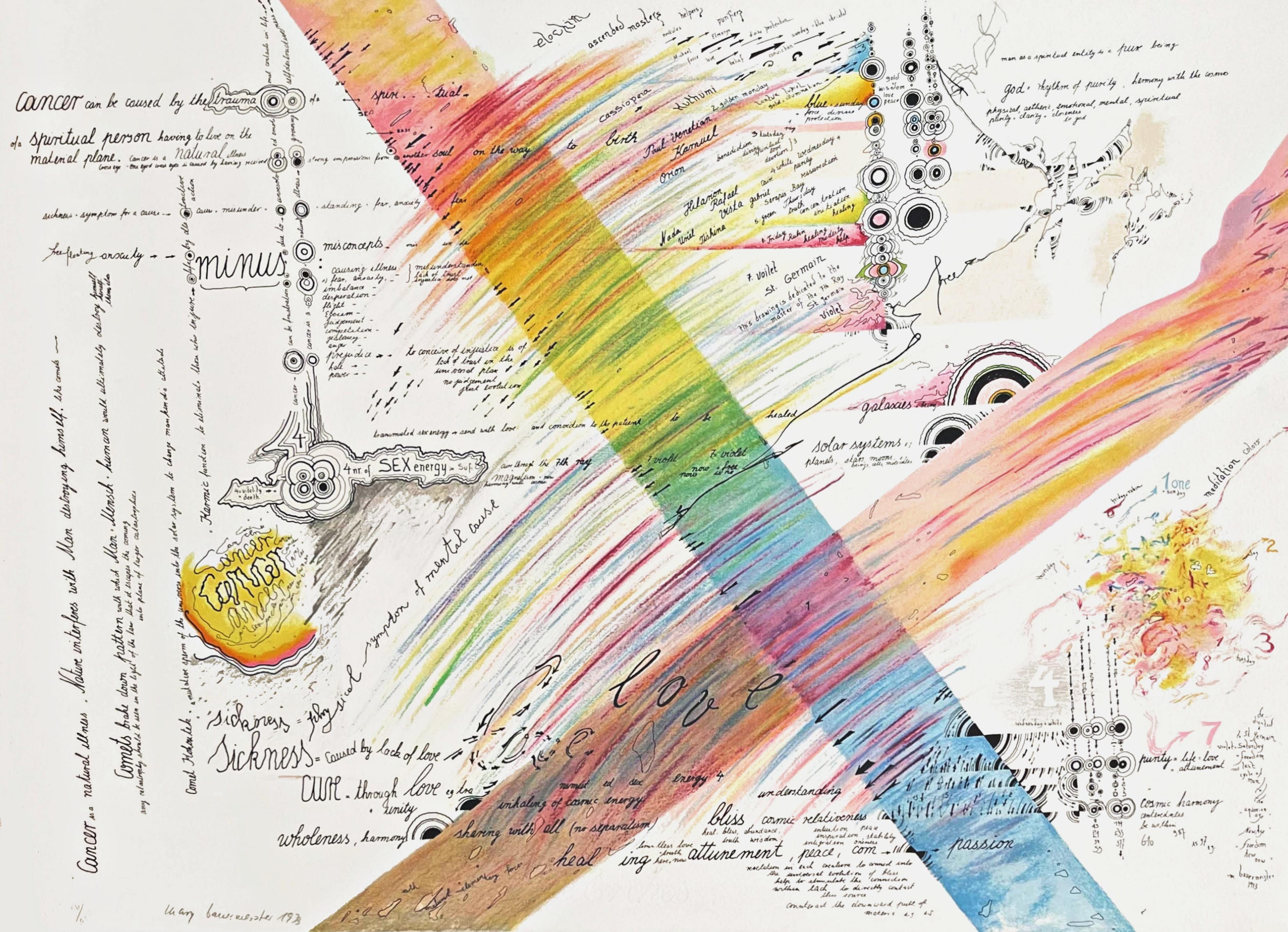Items Similar to Do You Know...?, from the New York Collection for Stockholm portfolio (Signed/N)
Want more images or videos?
Request additional images or videos from the seller
1 of 10
Nam June PaikDo You Know...?, from the New York Collection for Stockholm portfolio (Signed/N)1973
1973
About the Item
Nam June Paik
Do You Know...?, from the New York Collection for Stockholm portfolio, 1973
Silkscreen on paper, in original portfolio sleeve
Signed and dated '73 and numbered 36/300 in graphite pencil recto. text verso: "Copyright 1973 by Nam June Paik Printed at Styria Studios"
12 × 9 inches
Unframed; held in original stamped portfolio sleeve
Pencil signed and numbered 36/300; held in original portfolio sleeve with Crane's Bond #1 paper and artist's name stamped on the outside (see photograph).
Rarely to market, this classic Nam June Paik screenprint on rag paper, was created in 1973 for the legendary "New York for Stockholm" portfolio. Other editions of this print are in the permanent collections of many major museums and public institutions worldwide, which is why they're not often to market, including the Metropolitan Museum of Art, the Museum of Modern Art, the Smithsonian American Art Museum, Moderna Museet, the Walker Art Center, the Los Angeles County Museum of Art, the Dayton Art Institute, the Frost Art Museum,the Herbert F. Johnson Museum of Art, the San Diego Museum of Art, the Princeton University Art Museum, the Pierpoint Morgan Library, and the Albertina Museum, the Kempner Art Museum - to name only a few.
Many works from this portfolio are already in the permanent collections of most major museums and public institutions worldwide.
Held in original portfolio sleeve (see photos)
Publisher:
Experiments in Art & Technology, publisher; Styria Studio printer
- Creator:Nam June Paik (1932 - 2006, American, Korean)
- Creation Year:1973
- Dimensions:Height: 12 in (30.48 cm)Width: 9 in (22.86 cm)
- Medium:
- Movement & Style:
- Period:
- Condition:Very good condition; held in original portfolio sleeve.
- Gallery Location:New York, NY
- Reference Number:1stDibs: LU1745212966592
About the Seller
5.0
Platinum Seller
These expertly vetted sellers are 1stDibs' most experienced sellers and are rated highest by our customers.
Established in 2007
1stDibs seller since 2022
289 sales on 1stDibs
Typical response time: 1 hour
- ShippingRetrieving quote...Ships From: New York, NY
- Return PolicyA return for this item may be initiated within 1 day of delivery.
More From This SellerView All
- My Love We Wont - coveted, whimsical 1960s silkscreen by beloved female artistBy Niki de Saint PhalleLocated in New York, NYNiki de Saint Phalle My Love We Wont, 1968 Lithograph and silkscreen on wove paper Signed and numbered 51/75 in graphite pencil on the front Frame included: elegantly floated and framed in a museum quality white wood frame with UV plexiglass From the Brooklyn Museum, which has an edition of this work in its permanent collection: "Throughout her long and prolific career Niki de Saint Phalle, a former cover model for Life magazine and French Vogue, investigated feminine archetypes and women’s societal roles. Her Nanas, bold, sexy sculptures...Category
1960s Modern Abstract Prints
MaterialsScreen, Mixed Media, Lithograph, Pencil
- Rainbow Signed 1970s silkscreen & lithograph by pioneering female Fluxus artistBy Mary BauermeisterLocated in New York, NYMary Bauermeister Rainbow, 1973 Lithograph and silkscreen on creamy white paper Hand signed, dated and numbered 56/250 by the artist on the front 19 x 25.5 inches Unframed This work is on the permanent collection of various institutions like: Rice University, Samuel Dorksy Museum of Art, Rutgers Zimmerli Museum and Wheaton College Massachusetts. While studying the fringe sciences the 1970s, Bauermeister created Rainbow (1973), a lithograph and silkscreen. She uses a creamy white background as the base. Two intersecting diagonal bands of color transcend across the page, and black cursive lettering dances over the surface serving as a mind map of interweaving ideas. Through the central band, Bauermeister shifts through the color spectrum; she begins with red and finishes with violet. Inspired by music, she uses strokes of color that are rhythmically smeared across the lithograph. The surface lettering, a kind of visual poetry, explores her interest in human emotion and science. The viewer can see Bauermeister’s thoughts as they flow into one another through the use of words such as bliss, love, and healing. Bauermeister also includes a repetition of words such as cancer, sickness, and cure. The word cancer emerges from a cell-like shape. A careful study of the words shows that they may seem dark in nature; however, she juxtaposes these words against the cheerful title and colors. Perhaps the rainbow symbolizes a new hope, an inspiration for an optimistic future. -Courtesy to the Samuel Dorsky Museum of Art About Mary Bauermeister: A multidisciplinary artist known for her intricate and enigmatic assemblages, Mary Bauermeister (1934-2023) continues to defy categorization with layered works in a range of media. A precursory figure of the Fluxus movement—her studio was the meeting point for a number of defining artists of the avant-garde—her work plays an integral role in the discussion of art, both European and American, that emerged from the 1960s. Her reliefs and sculptures, which have incorporated drawing, text, found objects, natural materials and fabric, reference a plethora of concepts: from natural phenomena and astronomy to mathematics and language, as well as her own “spiritual-metaphysical experiences.” Maturing amidst the currents of Minimalism and Pop Art, Bauermeister’s art has resisted labels due to the singular expression of her interests and concerns, among them the simultaneous transience and permanence of the natural world with experimentations in transparency and magnification, multiplication and variation, structure and order, chance and ephemerality, introversion and extroversion. Her three-dimensional receptacles of thoughts, ideas, and notes contain visual, conceptual, and philosophical paradoxes that challenge perceptions and that offer literal and metaphorical windows into which one can glimpse the inner workings of the artist’s mind. - Courtesy of Michael Rosenfeld...Category
1970s Modern Abstract Prints
MaterialsLithograph, Screen, Mixed Media, Pencil, Graphite
- Shalom Pax Paix (The Peace Print) silkscreen on Rives BFK paper signed/N 35/50By Robert IndianaLocated in New York, NYRobert Indiana Pax, Paix, Shalom (The Peace Print), 2004 Silkscreen in 4 colors on rives BFK paper Hand signed, dated, titled and numbered 35/50 in pencil by Robert Indiana on the f...Category
Early 2000s Pop Art Figurative Prints
MaterialsPencil, Screen
- I Rather Like You A Lot You FoolBy Niki de Saint PhalleLocated in New York, NYNiki de Saint Phalle I Rather Like You A Lot You Fool, 1970 Silkscreen on wove paper Signed and numbered 74//75 in graphite pencil on the front Frame included Signed and numbered 74...Category
1970s Abstract Abstract Prints
MaterialsScreen, Pencil, Graphite
- Aufbruch Aus Moskau MockBa: Suite of 20 signed prints top Russian artists 64/100Located in New York, NYVARIOUS ARTISTS AUFBRUCH AUS MOSKAU MOCKBA - PORTFOLIO OF TWENTY (20) ORIGINAL LIMITED EDITION SIGNED GRAPHICS, 1990 20 Limited edition, hand signed and numbered Screenprints, unfram...Category
1990s Pop Art Abstract Prints
MaterialsMixed Media, Screen, Linen, Pencil
- Santa Fe Opera (Deluxe VIP Edition; Hand Signed & Numbered AP Edition of 50)By Robert IndianaLocated in New York, NYROBERT INDIANA Santa Fe Opera (Hand signed, numbered), 1976 Silkscreen on wove paper 37 1/2 × 27 inches Edition AP 7/50 Hand Signed and dated lower rig...Category
1970s Pop Art Abstract Prints
MaterialsScreen, Pencil, Graphite
You May Also Like
- Geometric Woman's Portrait - Rare Signed Graphite Drawing on Paper 1962Located in Soquel, CAGeometric Woman's Portrait - Rare Signed Graphite Drawing on Paper 1962 Beautiful, soft original drawing by Eugene Hawkins (American, b. 1933). A realistic depiction of a short-haired woman, her large lips parted into a soft smile. She's surrounded in geometric shapes offering a wonderful juxtaposition to the natural curves of her face and hair. Signed in pencil, "Eugene Hawkins '62" Presented in a new black mat. Mat size: 20"H x 16"W Paper size: 18.5"H x 14.5"W Eugene Hawkins (American, b. 1933) is a BIPOC artist known for his detailed portraiture and printmaking. He is listed in Who Was Who in American Art, 1564-1975, and his work was exhibited in the Whitney Museum of American Art. He spent the majority of his life working and exhibiting in Southern California. His work frequently touches upon socio-political subjects, making strong statements about the world. The California African American Museum features Eugene Hawkins's work in the Permanent Collection. Exhibition: 2017 Paperworks: Selections from the Permanent Collection focuses on works on paper produced from 1950-2000 and includes figurative, impressionistic, and abstract styles. The exhibition showcases the radically diverse range of works on paper created by African American and other artists over the last two centuries, and includes drawings, prints, paintings, and collages by Edward Mitchell Bannister...Category
1960s American Modern Figurative Prints
MaterialsGraphite, Paper
- "Sacrifice Economy" Silkscreen 39" x 27.5" inch by Patricio GonzalezBy Patricio GonzalezLocated in Culver City, CA"Sacrifice Economy" Silkscreen 39" x 27.5" inch by Patricio Gonzalez Silkscreen Not framed From "Looking for Happiness" series LOOKING FOR HAPPI...Category
21st Century and Contemporary Modern Abstract Prints
MaterialsScreen
- Mother and ChildBy Romare BeardenLocated in New York, NYA very good impression of this color screenprint. Signed and numbered 200/15 in pencil by Bearden. Catalogue reference: Gelburd/Rosenberg GG#59Category
1970s Modern Figurative Prints
MaterialsColor, Screen
- Propagation-L, mid century figurative abstract screenprint, 20th century artistBy Takesada MatsutaniLocated in Beachwood, OHTakesada Matsutani (Japanese, b. 1937) Propagation-L, 1971 Screenprint in colors Edition 51/75 28 x 27 inches 28.25 x 27.25 inches, framed Takesada Matsutani is a Japanese avant-ga...Category
1970s Modern Abstract Prints
MaterialsScreen
- (Partial) Portfolio containing 3 (three) lithographs and etchingsBy GraficaLocated in Kansas City, MOGrafica '68 (Partial) Portfolio containing 3 (three) lithographs and etchings Originally issued with 10 Lithographs, Silk Screens and Etchings, of which 7 (seven) are missing Year: 1968 Edition: 100 Size: 17.6 x 23.6 in. or 23.6 x 17.6 in. Publisher: Il Torcoliere, Rome - Italy Signatures: Sheets signed and numbered by hand Comes with folio box and individual artists' presentation sheets. --------------------------------- Artists works included: RENZO VESPIGNANI "Report on the artist" Year: 1968 Medium: Lithograph in two colors Edition: 100 Size: 17.6 x 23.6 in. Publisher: Il Torcoliere, Rome - Italy Signed and numbered Ref: RVE_1909_01 LUCIANO DE VITA "Le cavalier inconnu" Year: 1968 Medium: Etching Edition: 100 Size: 23.6 x 17.6 in. Publisher: Il Torcoliere, Rome - Italy Signed and numbered Ref: LDV_1909_01 PIERO GUCCIONE "Images" Year: 1968 Medium: Lithograph in four colors Edition: 100 Size: 23.6 x 17.6 in. Publisher: Il Torcoliere, Rome - Italy Signed and numbered Ref: PGU_1909_01 ======================= Renzo Vespignani was an Italian painter, printmaker and illustrator. Vespignani illustrated the works of Boccaccio, Kafka and T. S. Eliot, among others. In 1956, he co-founded the magazine Citta Aperta and in 1963, co-founded the group II Pro e II Contro for neorealism in figure art. ---------------- Luciano De Vita ( Ancona , 1929 - 1992 ) was an Italian painter , engraver , set designer and lecturer . Born in Ancona, De vita arrived in Bologna in the first post-war period, after having actively participated in the Second World War and having suffered the dramatic consequences. He attended the Academy of Fine Arts and was a pupil of Giorgio Morandi. From 1962 he taught in Milan at the Brera Academy , while in 1975 he returned to Bologna where he obtained the same chair of engraving that had been Morandi's from 1930 to 1956 . De Vita also actively dedicated himself to the theater , overseeing sets and costumes for shows that were also staged at La Scala in Milan. An example is the Turandot curated by Raoul Grassilli. ---------------- Emilio Vedova (9 August 1919 – 25 October 2006) was a modern Italian painter...Category
1960s Modern Figurative Prints
MaterialsEtching, Lithograph, Screen
- Modernist Figurative Pop Art Etching and Aquatint "the Artist" Michael MazurBy Michael MazurLocated in Surfside, FLMichael Mazur "The Artist" Hand signed and editioned from the edition of 50 1967 Michael Burton Mazur (1935-August 18, 2009) was an American artist who was described by William Grimes of The New York Times as "a restlessly inventive printmaker, painter, and sculptor." Born and raised in New York City, Mazur attended the Horace Mann School. He received a bachelor's degree from Amherst College in 1958, then studied art at Yale. Mazur first gained notice for his series of lithographs and etchings of inmates in a mental asylum, which resulted in two publications, "Closed Ward" and "Locked Ward." Over the years, he worked in printmaking and painting. His series of large-scale prints for Dante's Inferno won critical acclaim, and were the subject of a traveling exhibition organized by the University of Iowa in 1994. Later he concentrated on creating large, lyrical paintings which make use of his free, gestural brushwork and a varied palette. Some of these paintings were seen in an exhibition of 2002 at Boston University, "Looking East: Brice Marden, Michael Mazur, and Pat Steir." (See also Susan Danly, "Branching: The Art of Michael Mazur," 1997). The Museum of Fine Arts, Boston, has acquired a definMichael Mazur received a B.A. from Amherst College in 1957, studying in his senior year at the Accademia di Belle Arti in Florence, Italy. He went on to earn both a B.F.A. and an M.F.A. from the Yale School of Art and Architecture in 1961. Mazur's first teaching job was at the Rhode Island School of Design from 1961 to 1964. He was awarded a Guggenheim Foundation fellowship for 1964–65. From 1965 to 1976, he taught at Brandeis University, and from 1976 to 1978 at Harvard University. As an artist, teacher, and writer, Mazur has been active in reviving the monotype process. He contributed an essay to the pioneering exhibition catalogue The Painterly Print, published by the Metropolitan Museum of Art in 1980. Mazur recently chaired the New Provincetown Print...Category
Early 2000s American Modern Abstract Prints
MaterialsLithograph, Screen
Recently Viewed
View AllMore Ways To Browse
Tiffany In Palm Desert
Tiffany Palm Desert
Us 1012
Chinese Peasant Art
Durer Jerome
Dutch Hearts Jim Dine
Horst Janssen
Loch Earn
Madame Butterfly Poster
Renoir Maternite
Roy Lichtenstein Crak
Salvador Dali Last Supper
Saturn Messenger
Surrealist Piano Salvador Dali
Tiffany And Co Holiday China
1931 Rolex
Alberto Salietti On Sale
Art Print Rowena





